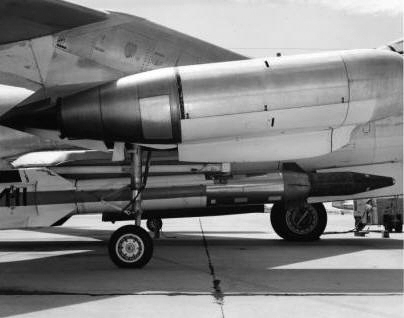Bold Orion on:
[Wikipedia]
[Google]
[Amazon]
The Bold Orion missile, also known as Weapons System 199B (WS-199B), was a prototype air-launched ballistic missile (ALBM) developed by Martin Aircraft during the 1950s. Developed in both one- and two- stage designs, the missile was moderately successful in testing, and helped pave the way for development of the GAM-87 Skybolt ALBM. In addition, the Bold Orion was used in early
volume 15
p.814.
 AMR DZ means Atlantic Missile Range Drop Zone.
AMR DZ means Atlantic Missile Range Drop Zone.
''Gunter's Space Page''.
''Gunter's Space Page''.
''spaceline.org''. {{USAF system codes Air-launched ballistic missiles Ballistic missiles of the United States Anti-satellite missiles Cold War air-to-surface missiles of the United States Air-to-surface missiles of the United States
anti-satellite weapon
Anti-satellite weapons (ASAT) are space weapons designed to incapacitate or destroy satellites for Military strategy, strategic or Military tactics, tactical purposes. Although no ASAT system has been utilized in warfare, a few countries (China, ...
s testing, performing the first interception of a satellite by a missile.
Design and development
The Bold Orion missile was developed as part of Weapons System 199, initiated by theUnited States Air Force
The United States Air Force (USAF) is the Air force, air service branch of the United States Department of Defense. It is one of the six United States Armed Forces and one of the eight uniformed services of the United States. Tracing its ori ...
(USAF) in response to the U.S. Navy's Polaris
Polaris is a star in the northern circumpolar constellation of Ursa Minor. It is designated α Ursae Minoris (Latinisation of names, Latinized to ''Alpha Ursae Minoris'') and is commonly called the North Star or Pole Star. With an ...
program, with funding authorised by the United States Congress
The United States Congress is the legislature, legislative branch of the federal government of the United States. It is a Bicameralism, bicameral legislature, including a Lower house, lower body, the United States House of Representatives, ...
in 1957.Yengst 2010, p.37. The purpose of WS-199 was the development of technology that would be used in new strategic weapons for the USAF's Strategic Air Command
Strategic Air Command (SAC) was a United States Department of Defense Specified Command and a United States Air Force (USAF) Major Command responsible for command and control of the strategic bomber and intercontinental ballistic missile compon ...
, not to deliver operational weapons; a primary emphasis was on proving the feasibility of an air-launched ballistic missile.Parsch 2005Stares 1985, p.109.
The designation WS-199B was assigned to the project that, under a contract awarded in 1958 to Martin Aircraft, would become the Bold Orion missile. The design of Bold Orion was simple, using parts developed for other missile systems to reduce the cost and development time of the project. The initial Bold Orion configuration was a single-stage vehicle, using a Thiokol TX-20 Sergeant solid-fuel rocket. Following initial testing, the Bold Orion configuration was altered to become a two-stage vehicle, an Allegany Ballistics Laboratory Altair upper stage being added to the missile.
Operational history
Having been given top priority by the Air Force, the first flight test of the Bold Orion missile was conducted on May 26, 1958, from a Boeing B-47 Stratojet carrier aircraft, which launched the Bold Orion vehicle at the apex of a high-speed, high-angle climb.Temple 2004, p.111. The zoom climb tactic, combined with thethrust
Thrust is a reaction force described quantitatively by Newton's third law. When a system expels or accelerates mass in one direction, the accelerated mass will cause a force of equal magnitude but opposite direction to be applied to that ...
from the rocket motor of the missile itself, allowed the missile to achieve its maximum range, or, alternatively, to reach space.
A twelve-flight test series of the Bold Orion vehicle was conducted;. Despite suffering only one outright failure, the initial flight tests of the single-stage rocket proved less successful than hoped. Authorisation was received to modify the Bold Orion to become a two-stage vehicle. In addition to the modifications improving the missile's reliability, they increased the range of Bold Orion to over . Four of the final six test firings were of the two-stage vehicle. These were considered successful, and established that the ALBM was a viable weapon.
ASAT test
The final test launch of Bold Orion, conducted on October 13, 1959, was a test of the vehicle's capabilities in the anti-satellite role. Piloted by Carl E Brust Jr, the missile was launched from an altitude of from its B-47 mothership, the missile successfully intercepted the Explorer 6 satellite, passing its target at a range of less than at an altitude of . If the missile had a nuclear warhead, the satellite would have been destroyed. The Bold Orion ASAT test was the first interception of a satellite by any method, proving that anti-satellite missiles were feasible.Peebles 1997, p. 65. This test, along with an earlier, unsuccessful test of the High Virgo missile in the anti-satellite role, had political repercussions. The Eisenhower administration sought to establish space as a neutral ground for everyone's use, and the "indication of hostile intent" given by the tests was frowned upon, with anti-satellite weapons development being soon curtailed.Legacy
The results of the Bold Orion project, along with those from the testing of the High Virgo missile, also developed under WS-199, provided data and knowledge that assisted the Air Force in forming the requirements for the follow-on WS-138A, which would produce the GAM-87 Skybolt missile. International Aeronautic Federation. ''Interavia'volume 15
p.814.
Launch history
 AMR DZ means Atlantic Missile Range Drop Zone.
AMR DZ means Atlantic Missile Range Drop Zone.
See also
References
Citations
Bibliography
* * * * * * * * * * * * * * * *Further reading
*External links
''Gunter's Space Page''.
''Gunter's Space Page''.
''spaceline.org''. {{USAF system codes Air-launched ballistic missiles Ballistic missiles of the United States Anti-satellite missiles Cold War air-to-surface missiles of the United States Air-to-surface missiles of the United States